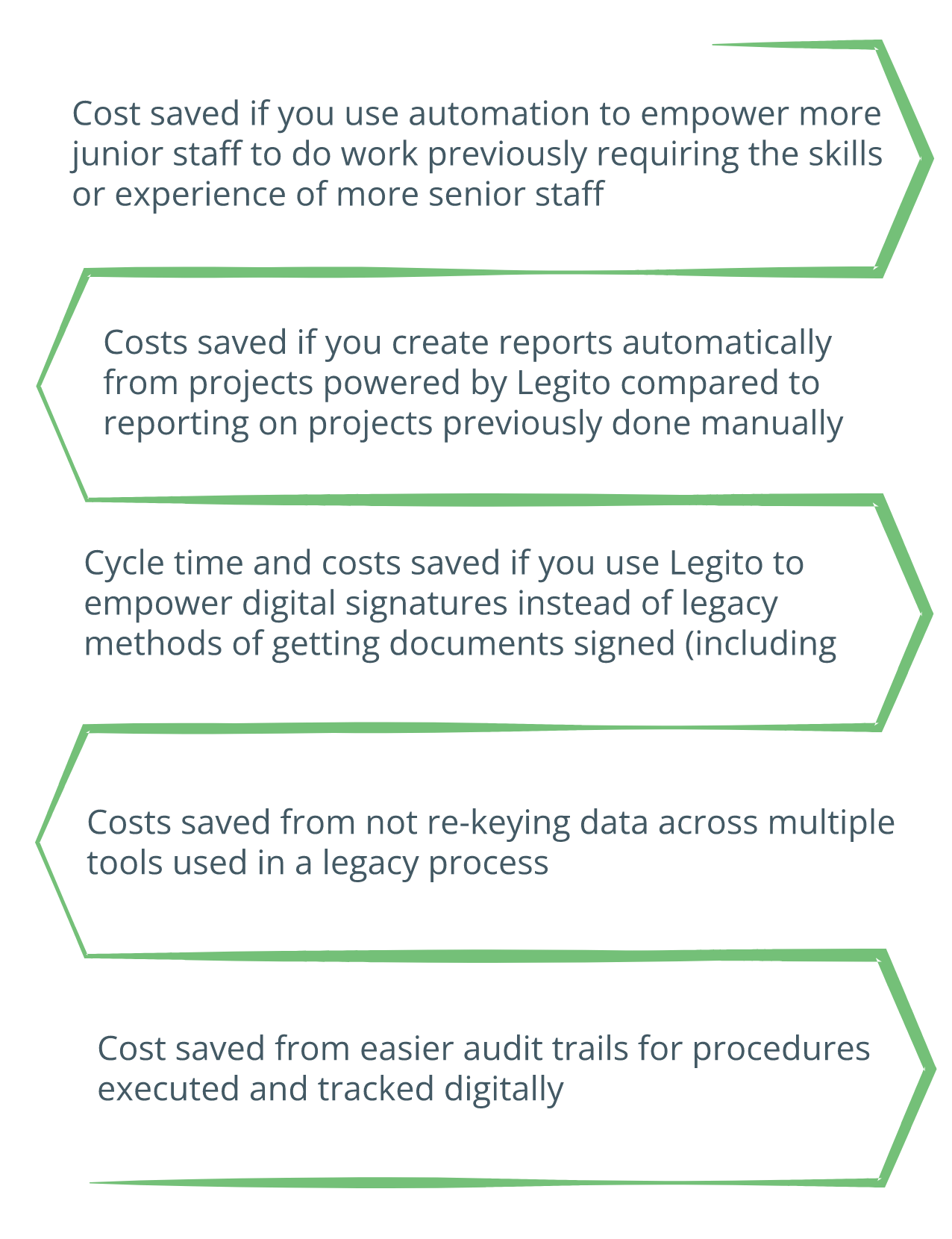The business case and ROI for Legito deployments

Charles Drayson
Nov 17 · 5 min read

A business case is not the same as a predicted return on investment (ROI), even if those terms seem to be used interchangeably. The objective is to demonstrate that a project is worth doing, perhaps to gain executive support, but perhaps to satisfy yourself before you put your reputation on the line. I suggest a business case is a reason to execute a project, and an ROI is an accounting device to project a financial advantage that includes figures for the costs and the rewards. It’s useful to consider both concepts, even if you are not asked for both. Otherwise, you might overlook some gems.
Long before Legito existed, I deployed a first-generation document automation solution for a sales team of 70+ people. I had a personal need to make the project work (I was struggling to do my job without something to bring order out of chaos), but I needed a more corporate motivation to win support for the project. Some projects will have a solid business case without a compelling ROI unless you take a wide interpretation of ‘return’ in an ROI calculation (a risky approach if your audience is cynical).
My first project appeared to be one of those. External events (think litigation, disgruntled shareholders, demanding audit conditions) transpired to deliver a clear imperative to deliver good governance of the sales / contracts /invoicing process. Cost savings, efficiencies, and cycle times were not on the list of objectives. Just fix a broken process.
Sometimes, the need to change is self-evident. Don’t let a request for an ROI obscure a manifest business need. Call the business case what it is.
My observation from supporting sales teams in the IT industry is that sponsors respond to an overwhelming business case even if they have asked for an ROI. Some bid teams try to express the business case using an ROI, and there’s no harm in that if the message isn’t lost in translation. Don’t let the numbers do a job that ought to be done by a clear statement of need. If one relies on an ROI as the principal expression of a business case, people try to assign numbers to some benefits that are tricky to express numerically with much precision or evidence. If that happens, cynics find it easy to pick a fight with the numbers, and the battle is lost.
Looking back on many projects related to document-orientated solutions, there was a business case that could be readily expressed with a few statements of need. Still, it was also possible to build a compelling ROI, even if some of the returns were incidental or perhaps unrelated to addressing the stated needs.
This is a particular problem for projects designed to promote governance and compliance. You could build an ROI calculation using numbers based on projected penalties from fines or litigation. However, many organisations have no direct experience of costly litigation or the heavy hand of regulatory fines, so the numbers might look too remote. The same difficulty applies to putting a number on lost business opportunities. In some industries, an organisation wouldn’t survive to recover from a governance or compliance failure. There’s no reliable data to put a figure on lost business. In those cases, speak truth unto power and be clear about the need. If the need isn’t sufficiently compelling, the project isn’t going to get support regardless of the ROI.
The project I described as a ‘just fix a broken process’ did deliver an impressive ROI, even if that was not our objective. If you can deliver ROI while meeting business needs, it will be easier to command support. Moreover, it could be the difference between getting mere approval for deployment and getting resources needed to increase the likelihood of success (for example, a budget to buy in some external consultancy assistance).
Try a Free Trial
Before you build an ROI for Legito, take a free trial. A free trial is a great way to build confidence that you have selected the correct tool, but it is also an opportunity to experiment with a prototype solution to generate metrics for an ROI. The Legito consulting team sometimes gets involved in a trial project. Legito consultants can often build a rapid initial solution sufficient to prove capability as well as helping you to measure some initial results.
Legito projects often start with a document automation project (automatic production of tailored documents using variable data) to replace a legacy process of manual document creation. The time saved from manual document creation to automated drafting is easy to measure, and frequently reveals obvious savings with irrefutable evidence.

When measuring the benefits from Legito document automation, be sure to consider the cost of people checking for errors, fixing errors, and resolving formatting issues associated with legacy document drafting.
Here is a list of metrics you might consider measuring when building an ROI calculation:

Legito projects typically start small and expand after an initial quick deployment. It is usually possible to build a good ROI for a starter project – there’s no need to over-complicate the calculation by projecting results over a long IT project.
If you need help with an ROI, the Legito consultants have the experience to provide metrics from comparable projects. However, there’s nothing like a trial project to prove them for yourself.

Nov 17 · 5 min read
A business case is not the same as a predicted return on investment (ROI), even if those terms seem to be used interchangeably. The objective is to demonstrate that a project is worth doing, perhaps to gain executive support, but perhaps to satisfy yourself before you put your reputation on the line. I suggest a business case is a reason to execute a project, and an ROI is an accounting device to project a financial advantage that includes figures for the costs and the rewards. It’s useful to consider both concepts, even if you are not asked for both. Otherwise, you might overlook some gems.

Long before Legito existed, I deployed a first-generation document automation solution for a sales team of 70+ people. I had a personal need to make the project work (I was struggling to do my job without something to bring order out of chaos), but I needed a more corporate motivation to win support for the project. Some projects will have a solid business case without a compelling ROI unless you take a wide interpretation of ‘return’ in an ROI calculation (a risky approach if your audience is cynical).
My first project appeared to be one of those. External events (think litigation, disgruntled shareholders, demanding audit conditions) transpired to deliver a clear imperative to deliver good governance of the sales / contracts /invoicing process. Cost savings, efficiencies, and cycle times were not on the list of objectives. Just fix a broken process.
Sometimes, the need to change is self-evident. Don’t let a request for an ROI obscure a manifest business need. Call the business case what it is.
My observation from supporting sales teams in the IT industry is that sponsors respond to an overwhelming business case even if they have asked for an ROI. Some bid teams try to express the business case using an ROI, and there’s no harm in that if the message isn’t lost in translation. Don’t let the numbers do a job that ought to be done by a clear statement of need. If one relies on an ROI as the principal expression of a business case, people try to assign numbers to some benefits that are tricky to express numerically with much precision or evidence. If that happens, cynics find it easy to pick a fight with the numbers, and the battle is lost.
This is a particular problem for projects designed to promote governance and compliance. You could build an ROI calculation using numbers based on projected penalties from fines or litigation. However, many organisations have no direct experience of costly litigation or the heavy hand of regulatory fines, so the numbers might look too remote. The same difficulty applies to putting a number on lost business opportunities. In some industries, an organisation wouldn’t survive to recover from a governance or compliance failure. There’s no reliable data to put a figure on lost business. In those cases, speak truth unto power and be clear about the need. If the need isn’t sufficiently compelling, the project isn’t going to get support regardless of the ROI.
Looking back on many projects related to document-orientated solutions, there was a business case that could be readily expressed with a few statements of need. Still, it was also possible to build a compelling ROI, even if some of the returns were incidental or perhaps unrelated to addressing the stated needs.
The project I described as a ‘just fix a broken process’ did deliver an impressive ROI, even if that was not our objective. If you can deliver ROI while meeting business needs, it will be easier to command support. Moreover, it could be the difference between getting mere approval for deployment and getting resources needed to increase the likelihood of success (for example, a budget to buy in some external consultancy assistance).
Before you build an ROI for Legito, take a free trial. A free trial is a great way to build confidence that you have selected the correct tool, but it is also an opportunity to experiment with a prototype solution to generate metrics for an ROI. The Legito consulting team sometimes gets involved in a trial project. Legito consultants can often build a rapid initial solution sufficient to prove capability as well as helping you to measure some initial results. Legito projects often start with a document automation project (automatic production of tailored documents using variable data) to replace a legacy process of manual document creation. The time saved from manual document creation to automated drafting is easy to measure, and frequently reveals obvious savings with irrefutable evidence.

When measuring the benefits from Legito document automation, be sure to consider the cost of people checking for errors, fixing errors, and resolving formatting issues associated with legacy document drafting.
Here is a list of metrics you might consider measuring when building an ROI calculation:

Legito projects typically start small and expand after an initial quick deployment. It is usually possible to build a good ROI for a starter project – there’s no need to over-complicate the calculation by projecting results over a long IT project.
If you need help with an ROI, the Legito consultants have the experience to provide metrics from comparable projects. However, there’s nothing like a trial project to prove them for yourself.
The business case and ROI for Legito deployments

Nov 17 · 5 min read
A business case is not the same as a predicted return on investment (ROI), even if those terms seem to be used interchangeably. The objective is to demonstrate that a project is worth doing, perhaps to gain executive support, but perhaps to satisfy yourself before you put your reputation on the line. I suggest a business case is a reason to execute a project, and an ROI is an accounting device to project a financial advantage that includes figures for the costs and the rewards. It’s useful to consider both concepts, even if you are not asked for both. Otherwise, you might overlook some gems.

Long before Legito existed, I deployed a first-generation document automation solution for a sales team of 70+ people. I had a personal need to make the project work (I was struggling to do my job without something to bring order out of chaos), but I needed a more corporate motivation to win support for the project. Some projects will have a solid business case without a compelling ROI unless you take a wide interpretation of ‘return’ in an ROI calculation (a risky approach if your audience is cynical).
My first project appeared to be one of those. External events (think litigation, disgruntled shareholders, demanding audit conditions) transpired to deliver a clear imperative to deliver good governance of the sales / contracts /invoicing process. Cost savings, efficiencies, and cycle times were not on the list of objectives. Just fix a broken process.
Sometimes, the need to change is self-evident. Don’t let a request for an ROI obscure a manifest business need. Call the business case what it is.
My observation from supporting sales teams in the IT industry is that sponsors respond to an overwhelming business case even if they have asked for an ROI. Some bid teams try to express the business case using an ROI, and there’s no harm in that if the message isn’t lost in translation. Don’t let the numbers do a job that ought to be done by a clear statement of need. If one relies on an ROI as the principal expression of a business case, people try to assign numbers to some benefits that are tricky to express numerically with much precision or evidence. If that happens, cynics find it easy to pick a fight with the numbers, and the battle is lost.
This is a particular problem for projects designed to promote governance and compliance. You could build an ROI calculation using numbers based on projected penalties from fines or litigation. However, many organisations have no direct experience of costly litigation or the heavy hand of regulatory fines, so the numbers might look too remote. The same difficulty applies to putting a number on lost business opportunities. In some industries, an organisation wouldn’t survive to recover from a governance or compliance failure. There’s no reliable data to put a figure on lost business. In those cases, speak truth unto power and be clear about the need. If the need isn’t sufficiently compelling, the project isn’t going to get support regardless of the ROI.
Looking back on many projects related to document-orientated solutions, there was a business case that could be readily expressed with a few statements of need. Still, it was also possible to build a compelling ROI, even if some of the returns were incidental or perhaps unrelated to addressing the stated needs.
The project I described as a ‘just fix a broken process’ did deliver an impressive ROI, even if that was not our objective. If you can deliver ROI while meeting business needs, it will be easier to command support. Moreover, it could be the difference between getting mere approval for deployment and getting resources needed to increase the likelihood of success (for example, a budget to buy in some external consultancy assistance).
Try a Free Trial
Before you build an ROI for Legito, take a free trial. A free trial is a great way to build confidence that you have selected the correct tool, but it is also an opportunity to experiment with a prototype solution to generate metrics for an ROI. The Legito consulting team sometimes gets involved in a trial project. Legito consultants can often build a rapid initial solution sufficient to prove capability as well as helping you to measure some initial results. Legito projects often start with a document automation project (automatic production of tailored documents using variable data) to replace a legacy process of manual document creation. The time saved from manual document creation to automated drafting is easy to measure, and frequently reveals obvious savings with irrefutable evidence.

When measuring the benefits from Legito document automation, be sure to consider the cost of people checking for errors, fixing errors, and resolving formatting issues associated with legacy document drafting.
Here is a list of metrics you might consider measuring when building an ROI calculation:


Legito projects typically start small and expand after an initial quick deployment. It is usually possible to build a good ROI for a starter project – there’s no need to over-complicate the calculation by projecting results over a long IT project.
If you need help with an ROI, the Legito consultants have the experience to provide metrics from comparable projects. However, there’s nothing like a trial project to prove them for yourself.
More Industry Insights


















